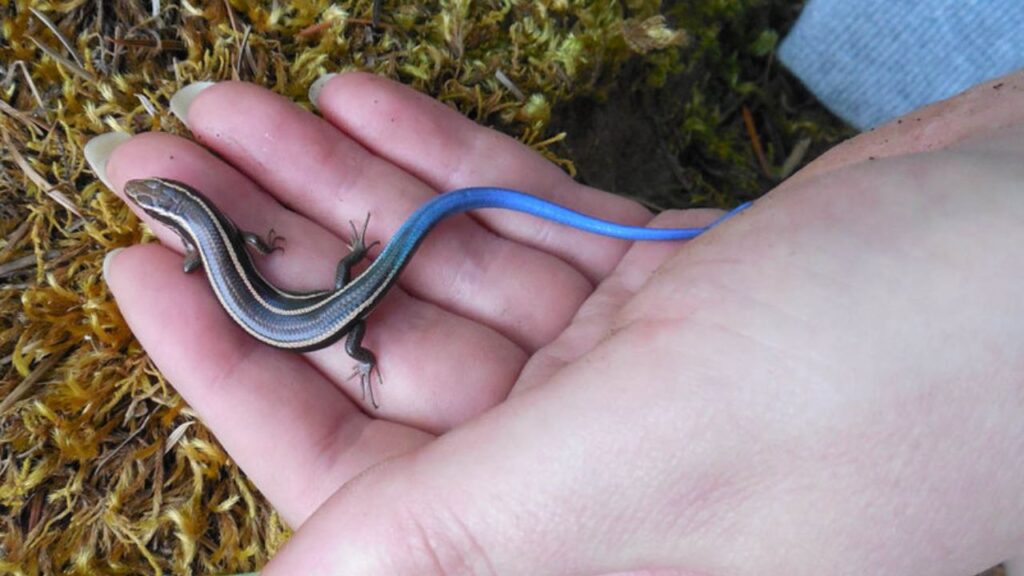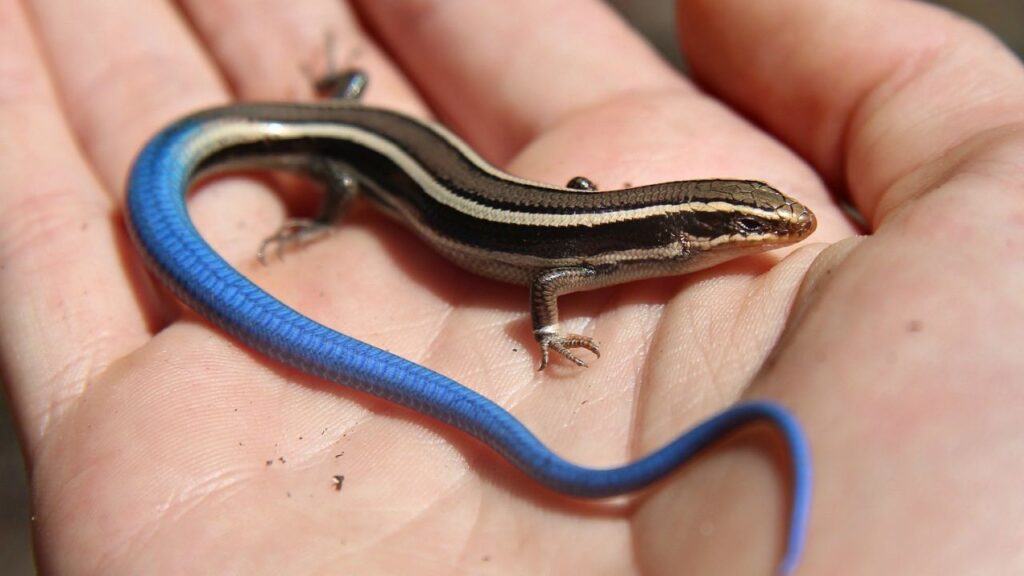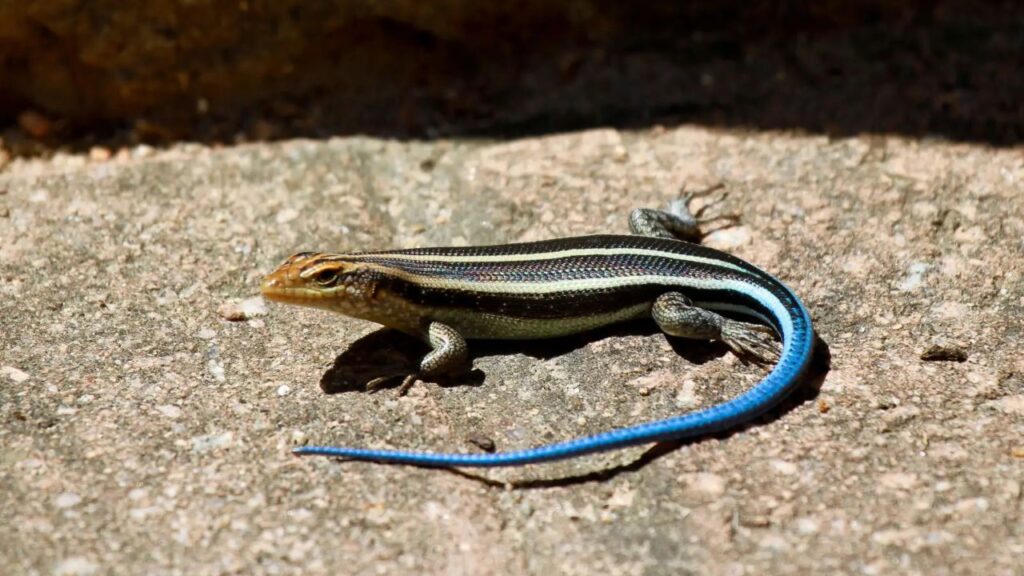The blue-tailed lizard is not just a pretty face; it’s a remarkable creature with significant roles in its ecosystem. Beyond its striking blue tail, these lizards display fascinating behaviors and adaptations that make them truly unique.
In this article, we’ll explore their habitats, dietary preferences, and reproductive strategies that highlight their survival skills.
Along the way, we’ll also address the challenges they face in the wild and their conservation status, raising important questions about their future.
Join us in discovering the intricate life of the blue-tailed lizard and what makes it an important part of our natural world.
Physical Characteristics
The blue-tailed lizard features a striking blue tail that contrasts sharply with its more muted body colors, making it easily recognizable in its natural habitat. This lizard typically has a slender body, which can range from 6 to 10 inches in length, including its tail. Its skin displays a variety of shades, including browns, greens, and grays, helping it blend into the environment. The blue tail, however, is a distinct feature that often attracts attention.
You’ll notice that the blue-tailed lizard has smooth, shiny scales, giving it a sleek appearance. Its limbs are well-developed, allowing for quick movement and agility, which is essential for escaping predators. The lizard’s eyes are large and round, providing excellent vision to spot potential threats or prey.
Another interesting characteristic is its ability to shed its tail when threatened, a process known as autotomy. This not only distracts predators but allows the lizard to escape. Once the tail regrows, it may not be as vibrant as before, but it serves its purpose.
Habitat and Distribution

Often found in warm, sunny environments, blue-tailed lizards thrive in a variety of habitats, including grassy fields, woodlands, and gardens. You’ll often spot them basking on rocks or logs, enjoying the sunlight. These lizards prefer areas with plenty of cover, such as shrubs and leaf litter, as it provides protection from predators. Their ability to adapt to different environments makes them quite versatile.
In terms of distribution, blue-tailed lizards are commonly found across North America, particularly in the southeastern regions. They favor environments that provide both warmth and moisture, which help them regulate their body temperature. You might see them in suburban areas, where they can often be found in backyards, especially if there are places to hide.
When exploring their habitats, keep an eye out for their vibrant blue tails, which are particularly noticeable against the backdrop of green foliage and brown earth. This coloration not only adds to their beauty but also serves as a form of camouflage. Understanding where these lizards live helps you appreciate their ecological role and the importance of preserving their natural habitats.
Diet and Feeding Habits
Feasting primarily on insects and other small invertebrates, blue-tailed lizards have a varied diet that supports their energy needs and active lifestyle. These lizards are opportunistic feeders, which means they’ll take advantage of whatever food sources are available in their environment. Understanding what they eat can help you appreciate their role in the ecosystem.
Here are three key components of their diet:
- Insects: They primarily consume ants, beetles, and grasshoppers, which are abundant in their habitats.
- Spiders: Blue-tailed lizards often catch and eat spiders, providing them with essential nutrients.
- Worms: Occasionally, they’ll munch on earthworms, adding variety to their meals.
While they’re adept at catching prey, blue-tailed lizards also rely on quick reflexes and agility to evade predators. Their diet not only supports their energy requirements but also plays an important role in controlling insect populations.
Behavioral Traits
When you observe blue-tailed lizards, you’ll notice their intriguing social interactions among species.
They also have distinct territorial defense mechanisms to protect their space.
Additionally, their mating rituals and displays are quite fascinating.
Understanding these behavioral traits will give you greater insight into their lives and habits.
Social Interactions Among Species
Social interactions among blue-tailed lizards reveal complex behavioral traits that contribute to their survival and social structure. These lizards exhibit a range of behaviors that help them navigate their environment and interact with each other. Understanding these interactions can give you insight into their lives.
Communication: Blue-tailed lizards use body language, including tail movements and head bobs, to communicate with one another. These signals can indicate a variety of messages, from warnings to courtship.
Social Hierarchy: Within groups, you’ll often find a social hierarchy. Dominant lizards may assert their status through displays of aggression or territorial behaviors, influencing their access to resources.
Cooperation: Curiously, these lizards also display cooperative behaviors. They may bask together in the sun to conserve heat or alert each other to potential predators, enhancing their chances of survival.
Territorial Defense Mechanisms
Blue-tailed lizards fiercely defend their territories using a combination of aggressive displays and strategic behaviors to ward off intruders. When they sense a potential threat, these lizards often perform visual signals, such as puffing up their bodies and flashing their vibrant blue tails. This display not only showcases their health and liveliness but also serves as a warning to other lizards.
In addition to visual cues, blue-tailed lizards may engage in physical confrontations. They can chase off rivals or engage in a brief wrestling match, using their speed and agility to gain an advantage. You might notice them using their environment to their benefit, hiding or climbing to higher ground when threatened.
Territorial markings, like scratch marks on trees and rocks, also play an essential role in their defense strategy. By marking their territory, they communicate to other lizards that the area is occupied.
Understanding these behaviors can help you appreciate the intricate social dynamics of blue-tailed lizards. Their complex mix of aggression, display, and territorial marking guarantees they maintain control over their chosen habitats.
Mating Rituals and Displays
Aggressive territorial displays often give way to intricate mating rituals, where blue-tailed lizards showcase their vibrant colors and behaviors to attract potential mates. During the mating season, males become particularly active, using various techniques to impress females. Their bright blue tails serve as a visual signal, indicating health and liveliness.
Here are three key behaviors you might observe:
- Head Bobbing: Males often perform a rhythmic head bobbing, signaling their readiness to mate. This movement not only shows off their striking colors but also establishes dominance.
- Chasing: Males may chase each other to establish hierarchies. This behavior is essential for determining which lizard gets the chance to mate with females in the area.
- Vibrant Displays: When courting, males will display their full color range, puffing up and moving in exaggerated ways to catch a female’s attention. This display is critical for making a lasting impression.
Understanding these mating rituals helps you appreciate the blue-tailed lizard’s unique behaviors and the importance of visual signals in their social interactions. Observing these rituals can be a fascinating experience for any nature enthusiast.
Reproductive Strategies
The reproductive strategies of blue-tailed lizards involve complex behaviors that enhance their chances of successful mating and offspring survival. These lizards typically reach maturity in their first year, allowing them to participate in breeding sooner.
During the mating season, males display vibrant colors and engage in head-bobbing and push-up displays to attract females. This vibrant coloration can signal health and genetic fitness, which are appealing traits for potential mates.
Once a female selects a mate, she may lay between 5 to 15 eggs, usually in sandy or loose soil. The female often chooses locations that provide warmth and moisture, essential for successful incubation. After laying the eggs, she generally leaves them, relying on environmental conditions to support development.
In some cases, blue-tailed lizards exhibit a form of parental care by staying close to their nests, offering protection against predators. This strategy can increase the survival rate of the hatchlings.
Additionally, some studies suggest that females may store sperm from multiple males, allowing them to choose the best genetic material for fertilization. This flexibility in reproductive strategies helps guarantee that their lineage continues in various environmental conditions.
Lifespan and Growth

Many blue-tailed lizards can live up to five years in the wild, though factors like habitat and predation can impact their lifespan. In captivity, with proper care, they might live longer. Understanding their growth stages is essential for their well-being.
Here are three key growth stages you should know:
- Hatchlings: When they first emerge, blue-tailed lizards are tiny, measuring about 2-3 inches long. They rely heavily on their instincts and the cover of vegetation to survive.
- Juveniles: As they grow, these lizards start to develop their characteristic blue tails. During this stage, they may reach about 4-5 inches in length and become more active in their search for food.
- Adults: At maturity, blue-tailed lizards typically reach lengths of 7-10 inches. Their vibrant blue tails become more prominent, and they often establish a territory for feeding and breeding.
Predators and Threats
When you think about blue-tailed lizards, it’s important to take into account their natural predators and the threats they face in their habitats.
Various animals, including birds and snakes, see these lizards as a meal, which impacts their population.
Additionally, habitat loss from human activities further endangers their survival, making it essential to understand these challenges.
Natural Predators Overview
What predators threaten blue-tailed lizards in their natural habitats? These lizards face various threats from other animals that see them as potential meals. Understanding these predators can help you appreciate the challenges blue-tailed lizards encounter in the wild.
Here are three common predators of blue-tailed lizards:
- Birds: Many bird species, including hawks and crows, hunt for small reptiles like blue-tailed lizards. Their keen eyesight allows them to spot these lizards quickly.
- Snakes: Certain snake species, such as garter snakes and rat snakes, also prey on blue-tailed lizards. Their stealth and speed make them effective hunters in the lizard’s environment.
- Mammals: Small mammals, including cats, raccoons, and foxes, can pose a threat. These animals often scavenge areas where blue-tailed lizards live, making them vulnerable to predation.
Habitat Threats Explained
While blue-tailed lizards face numerous predators in their habitats, various environmental threats also impact their survival and well-being. One major threat is habitat destruction. Urban development, agriculture, and deforestation reduce the available living space for these lizards. When their homes are taken away, it becomes harder for them to find food and shelter.
Pollution is another significant concern. Chemicals from pesticides and waste can contaminate their environment, harming their health and reducing food sources. Additionally, climate change poses risks through rising temperatures and altered weather patterns, which can disrupt their breeding cycles and food availability.
Invasive species also threaten blue-tailed lizards. Non-native animals can compete for resources or even prey on them. This competition for food and territory can lead to further declines in their populations.
To protect blue-tailed lizards, it’s crucial to preserve their habitats and promote sustainable practices. Support local conservation efforts, and be mindful of how your actions impact their environment. By understanding these threats, you can help guarantee a brighter future for these unique reptiles.
Conservation Status
The conservation status of the blue-tailed lizard highlights its vulnerability due to habitat loss and environmental changes. As their natural habitats are destroyed, these lizards face increasing challenges to survive.
To help you understand the situation better, here are three key points regarding their conservation status:
- Habitat Destruction: Urbanization, agriculture, and deforestation are major threats. These activities reduce the areas where blue-tailed lizards can live and thrive.
- Climate Change: Rising temperatures and shifting weather patterns affect their food sources and breeding habits, making it harder for them to adapt.
- Pollution: Pesticides and chemicals in their environment can harm blue-tailed lizards directly or indirectly by contaminating their food supply.
Due to these factors, conservation efforts are essential. Protecting their habitats, promoting sustainable practices, and raising awareness about their plight can help guarantee a future for the blue-tailed lizard.
You can contribute by supporting local conservation initiatives and educating others on the importance of preserving these unique creatures. Every small action counts when it comes to safeguarding our planet’s biodiversity.
Captive Care and Maintenance

When caring for a blue-tailed lizard, you’ll need to focus on three key areas: housing requirements, diet and nutrition, and temperature and humidity.
Each of these factors plays an essential role in keeping your lizard healthy and thriving in a captive environment.
Let’s explore what you need to know to provide the best care possible.
Housing Requirements
Creating an ideal habitat for your blue-tailed lizard involves guaranteeing proper temperature, humidity, and space to thrive. You’ll want to provide a comfortable environment that mimics their natural habitat. Here are three key elements to focus on:
- Enclosure Size: A minimum of 20 gallons is recommended for one blue-tailed lizard. This gives them space to move, explore, and exercise, which is essential for their health.
- Temperature Gradient: Maintain a temperature range of 75°F to 85°F (24°C to 29°C) on the cool side and 85°F to 90°F (29°C to 32°C) on the warm side. Use heat lamps or under-tank heaters to create this gradient, allowing your lizard to regulate its body temperature.
- Humidity Levels: Aim for a humidity level of around 40-60%. You can achieve this by misting the enclosure regularly and providing a water dish.
Paying attention to these housing requirements will help keep your blue-tailed lizard healthy and happy. Regularly monitor the conditions in their enclosure and make adjustments as needed to guarantee they thrive.
Diet and Nutrition
Feeding your blue-tailed lizard a varied diet is vital for its overall health and vigor. These lizards thrive on a combination of insects and plant matter. Insects like crickets, mealworms, and roaches should make up a significant portion of their diet. Aim to feed them insects that are appropriately sized, usually no larger than the width of their head.
In addition to insects, you should include fresh vegetables and fruits. Leafy greens, such as collard greens and dandelion greens, are excellent choices. You can also offer small amounts of fruits like strawberries or blueberries as treats, but be cautious with the sugar content.
It’s important to dust their food with a calcium supplement a few times a week to guarantee they receive adequate nutrients. Always make certain to provide fresh water in a shallow dish, as hydration is vital for their well-being.
Monitor your lizard’s eating habits closely. If you notice any changes in appetite or weight, consult with a veterinarian who specializes in reptiles. A balanced diet will help your blue-tailed lizard live a healthy and active life.
Temperature and Humidity
Maintaining the right temperature and humidity levels is essential for your blue-tailed lizard’s health and well-being. These reptiles thrive in specific environmental conditions, so it’s vital to monitor and adjust their habitat accordingly.
Here are some key points to take into account:
- Temperature Gradient: Create a temperature gradient in the enclosure with a basking spot around 95°F (35°C) and a cooler area of about 75°F (24°C). This allows your lizard to regulate its body temperature effectively.
- Humidity Levels: Aim for humidity levels between 40% and 60%. You can achieve this by misting the enclosure daily and providing a shallow water dish. A hygrometer can help you keep track of humidity levels.
- Monitoring: Regularly check the temperature and humidity using thermometers and hygrometers. Adjust your heating sources, like heat lamps or under-tank heaters, as needed to maintain the ideal conditions.
Fun Facts and Myths
Blue-tailed lizards aren’t only fascinating creatures but also surrounded by intriguing myths and fun facts that capture the imagination.
One common myth is that their bright blue tails can regenerate into a new lizard if lost. While they do have the ability to regrow their tails, the new one is usually a different color and texture.
Did you know that blue-tailed lizards are often mistaken for being venomous due to their striking coloration? In reality, they’re completely harmless and primarily feed on insects, helping control pest populations in your garden.
Another fun fact is that these lizards can sprint at impressive speeds, making them difficult to catch. They can also display a unique defensive behavior, where they might drop their tails when threatened, allowing them to escape while the tail distracts predators.
Lastly, their vibrant blue color isn’t just for show; it plays a role in their communication and mating rituals.


